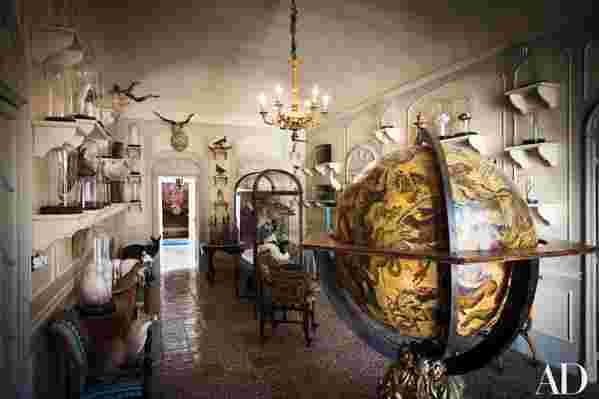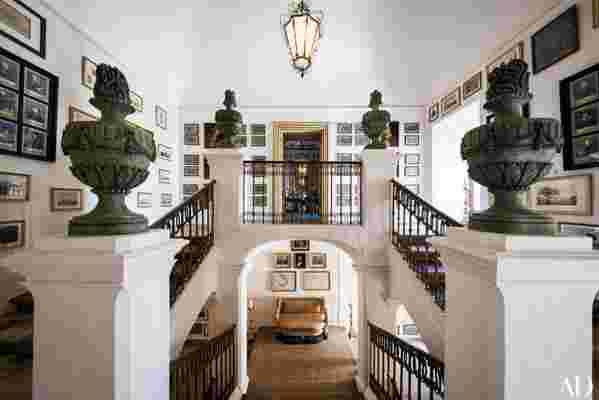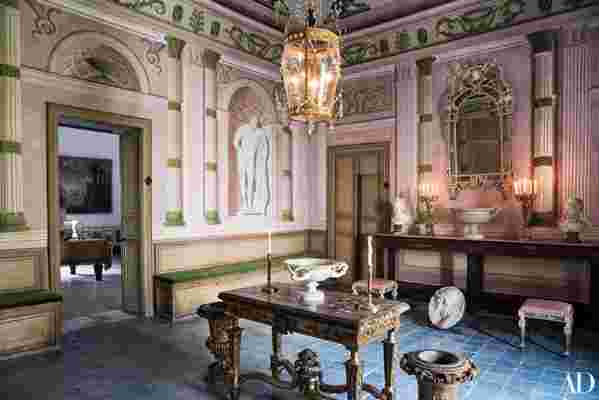See a Sicilian Palazzo Brought Back to Life
While a gusting storm turns the cobbled streets of the Sicilian city of Noto into quicksilver rapids, black-suited footmen illumine Palazzo di Lorenzo Castelluccio’s piano nobile with tall white candles, 30 tapers in the music room alone. Drenched dinner guests arrive, among them a photographer, an antiques dealer, a painter, a writer, and a composer. Restorative silver salvers of chilled Prosecco and hearty bruschetta are passed, and international politics dominates the conversation. Except for the visitors’ attire—blue jeans and duck boots prevail—Ferdinando I and Maria Carolina might still rule the Two Sicilies, as their bosom friend Emma Hamilton, en déshabillée, strikes Grecian attitudes for Admiral Nelson.



Relaxing in a gilded Italian Empire armchair is the host: a genial Continental businessman, goateed, self-made, Montecristo cigar in hand. Since childhood he has been riveted by the 18th and 19th centuries' more elegant moments, and now that he can afford to bring that past to life, he does, combining easygoing hospitality with curatorial authority.
Prime Sicilian art and furniture ll the palazzo’s salotti, each more marvelously muraled than the last. Sicilian food and wines are served in the gilt-papered dining room. Sicilian biographies, architecture books, and art histories are piled into the library’s glass-doored bookcases. If the ambience seems straight from the pages of Giuseppe Tomasi di Lampedusa’s The Leopard , the Sicilian Gone with the Wind , that’s not happenstance: The tale of a proud prince discom ted by the modern world is one of the businessman’s touchstones. Thus, the creation of romantic rooms like these, spaces that charm his friends—most of whom are captivated by anciens régimes, too, though with considerably less dedication.
“I thought it would be pleasing to live like the last Marchese di Castelluccio,” the owner grinningly explains. He has made similar utterances about other houses in his life. An aristocratic old property is purchased and a narrative develops, a re ned backstory that propels a fastidious renovation.
Dating from 1782, the palazzo, the owner says, had been shuttered since the 1970s, when the final marchese had died. Mold furred the walls, and rainwater poured through collapsed ceilings. “Almost all the furnishings had vanished,” the businessman says, who restored the place with architect Corrado Papa. “Except for the console in the entrance hall and an umbrella so rotted you could not use it.”
Hundreds of antique engravings, portraits, and sketches line the double staircase. The flaming urns, original to the palazzo, are stone painted to resemble bronze.
Today Palazzo di Lorenzo Castelluccio looks precisely as it was. Or, rather, as it might have been. The 1780s decors are a mystery; no evidence seems to exist. So the new owner played set designer, divining what the echoing rooms required, though atmospheric wear and tear ensures that nothing appears new. The boldly patterned tile oors, which thrillingly clash with the original murals—irrational exuberance is the Sicilian norm—were merely cleaned. “The worn paths are preserved,” the owner explains, pointing out a stretch of deeply distressed glaze, “so the ghosts are always with us.”
Damaged murals, from the pink entrance hall’s heroic trompe l’oeil statues to the ballroom’s delicate oral garlands, have been restored by Alexandrine Stordeur, a Noto-area decorative artist known for her work with the French interior decorator Jacques Garcia. (He’s fallen in love with Sicily, too, and has been over- hauling a countryside monastery for himself.) Another painter, Delphine Nény, is responsible for creating the so-called Salon Murat, a fantastical room that resembles a fringed tent, a fashion that became popular not long after the palace was constructed.
As for the gilded settees, the portraits of Sicilian and Neapolitan royals, the endless gouaches of Mount Etna blowing its top, the hundreds of unremarkable but decorative etchings massed on the double staircase, the owner tracked down every single one himself. Venerable crucifixes and reliquaries—the sort of antiques that few people covet, so the prices are low—once again pack the oratory off the dining room. (To the businessman’s disappointment, the Castelluccio chapel across the street, locked tight and in disrepair, was not part of the sale.) A barrel-vaulted space frosted with delicate moldings has become a cabinet of curiosities, with a profusion of birds’ eggs and mineral specimens, coral branches under bell jars, and taxidermy perched on chairs and shelves.
Palazzo di Lorenzo Castelluccio may be private property, but everything shown on these pages isn’t off-limits: Starting in May, tourists will be able to mount the double staircase and tour the piano nobile by appointment. (Go to palazzo castelluccioom for information.) “People should be able to see what these houses used to look like,” the owner says. “Not one palazzo in Noto is intact like this.” Of course, one man’s intact is this particular man’s artful invention, but given the splendor that he’s wrought, it’s a fantasy that’s about as real as it gets.
For the full story, subscribe now and get the digital edition immediately.